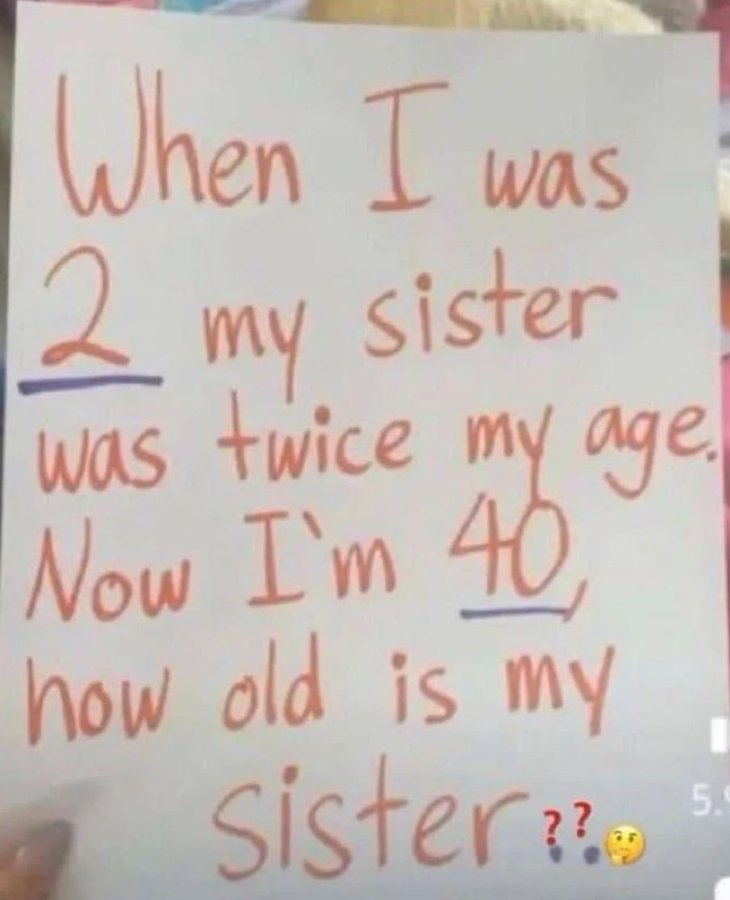Can You Solve This Age-Related Brain Teaser In Less Than 30 Seconds?
The internet has always been a treasure trove of entertainment and education, offering everything from hilarious memes to fascinating facts shared by influencers and vloggers. But among all the content that floods our feeds daily, there’s a particular category that has recently caught the public’s attention—brain teasers. These puzzles challenge your critical thinking skills and test your ability to apply logic and reasoning quickly. One such brain teaser has been making waves on social media, leaving many scratching their heads.

The brain teaser in question is deceptively simple but tricky enough to make you think twice. Here’s how it goes:
“When I was two, my sister was twice my age. Now I’m 40, how old is my sister?”
At first glance, it might seem like an easy question, but it has prompted a flurry of responses and debates online. People have been sharing their calculations and interpretations, often arriving at different answers.
So, why is this puzzle so tricky? The confusion seems to stem from overthinking the problem. Many people get caught up in complex calculations, trying to decipher whether the sister’s age should be calculated using some intricate mathematical formula. But the key to solving this puzzle lies in its simplicity.
Let’s take a closer look at the puzzle to see where people might be going wrong and how you can solve it in seconds.
The puzzle starts by telling us that when the narrator was 2 years old, their sister was twice their age. Simple math tells us that if the narrator was 2, their sister must have been 4 years old. This sets the stage for the age difference between the two siblings.
The critical piece of information here is that the sister was twice as old as the narrator when they were 2. This means the sister is 2 years older, and this age difference remains constant as both siblings age.
Fast forward to the present, where the narrator is now 40 years old. Since the sister is 2 years older, she would be 42 years old. That’s it—no complicated math required!
The trickiness of this puzzle lies in its wording, which can make people overthink the situation. The mention of “twice my age” when they were 2 can lead people to believe that some complex calculation is required, rather than recognizing that the age difference is a simple constant.
This brain teaser has garnered significant attention on social media, particularly on the X handle of Cocomellon, where it racked up over 200,000 views along with countless likes, retweets, and comments. The comments section has been buzzing with a variety of answers, ranging from correct solutions to more humorous interpretations.
Some users confidently shared their math, while others admitted to the challenge of figuring it out:
“42 na, unless she’s also aging twice as fast then she’d be 80 now.”
“The age difference between the two siblings is 4 – 2 = 2 years. Therefore, the person is now 2 + 40 = 42 years old. Their sister would be 4 + 40 = 44 years old.”
Others simply enjoyed the humor in the situation:
“No stress my brain abeg.”
“I swear I’m not stressing my brain.”
“Brain teaser…. Me wey never chop.”
The correct answer here is simply 42 years old. The puzzle is a classic example of how straightforward thinking can sometimes be the best approach. By keeping it simple and not complicating the problem, the answer becomes immediately clear.
Brain teasers like this one are popular because they engage our minds in a fun and challenging way. They encourage us to think critically and often reveal that the simplest solution is the correct one. Plus, they’re a great way to stimulate conversation and debate, as people share their interpretations and solutions.
In a world full of complex problems, sometimes it’s the simple puzzles that catch us off guard. This age-related brain teaser is a perfect example of how overthinking can lead us astray. The key takeaway? Keep it simple. The next time you’re faced with a tricky question, remember that the most straightforward answer is often the right one.



